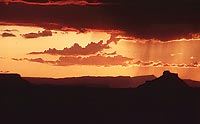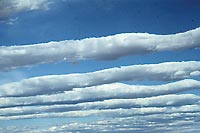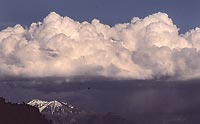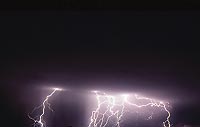The spectacular redrock landscape loses a little of its luster during the summer season when clouds are absent. Though the rocks take on the glow of sunrise and sunset they seemed washed out against a clear blue sky in the middle of the day. Framed by thunderheads or brushed by thin strands of cirrus clouds, the cloudscape compliments the landscape. 
Clouds also offer respite from the intense sun. The welcoming shade provides relief from the oven-like air. Plus, the clouds offer that vague promise of a badly needed rain, a promise which often evaporates like virga rain.
Hanging from the underbelly of a dark thunderhead are tentacles that seem like wisps of smoke. Although raindrops condense at higher elevations and descend towards the ground, the high temperatures and low humidity are not conducive to their longevity. The raindrops evaporate before they hit the ground, and these wisps are called virga.
Virga is Latin for “twig” or “branch” and that’s what these cloudy limbs resemble. The streaks form a dramatic image, but offer no relief.
In the canyons and low-lying deserts, beating the heat means being active in the early morning or later in the day. This crepuscular approach is one that many species of wildlife employ to avoid the midday sun.
Of course, another way to avoid being a parched desert rat is to go up in elevation, seeking mountain breezes and forests with trees larger than the starting center of the Utah Jazz. These dark forests of aspen, fir, spruce and pine provide shade against the sun. Mountain streams carry cold runoff from last winter’s snows and mountain breezes caress the skin.
But the mountains offer their own challenges to the summer skyscape. As hot air rises and picks up moisture, the mountains form an ideal structure against which thunderheads build.
Like the proverbial, “Where there’s smoke, there’s fire,” these thunderstorms may have lightning associated with them.
“When thunder roars, go indoors,” is a great rhyme for dealing with thunderstorms in Urban areas, but not when out in the mountains. When you see lightning start counting. Every 5 seconds represents one mile in distance, but lightning can easily travel many miles so a mile distant isn’t a safe buffer. Or start counting and if the thunder roars before 30 seconds are up, go indoors. Again, this 30-30 rule works in town or a campground if you are near a vehicle.
If the option to move indoors or into a vehicle or cave that is several times deeper than it is high doesn’t exist, consider another option. 
Move away from tall objects, especially the lone tree atop some mesa or the isolated rock spire. Move downslope, but stay out of ravines. Crouch down into a squat, but don’t lay flat on the ground. Toss the hiking poles aside and, if in a group, spread out 100’ apart. Gaze upwards or out towards another distant mesa and enjoy the view. Chances are pretty good, like 500,000 to 1, that you’ll be telling the tale of the thunderstorm from hell later in the evening.
And next time, when the forecast reads chance of afternoon thunderstorms, keep an eye on the sky and plan your adventure accordingly.




